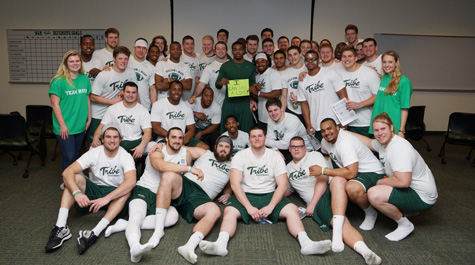Carpenter comes through in the game of life
John Carpenter will tell you that he had never won anything in his life – no lottery, raffle or free lunch – until August. And no matter how his luck fares from this point on, he’ll never win anything quite as important again.
His prize: The opportunity to give another human being life.
{{youtube:medium|L7BFgGjT4O8, John Carpenter discusses his decision to donate his blood stem cells.}}
It all started last spring for Carpenter, a senior kicker on the William & Mary football team. He and his teammates were approached by two high school seniors, one of them Madeline Montgomery, the daughter of Joe Montgomery ’74, a former football star for the Tribe. They wanted to know if the team would agree to be tested and added to the national registry of potential bone marrow donors.
Everyone on the team agreed to be tested. Even coach Jimmye Laycock tried to volunteer “but they told me I was too old,” he joked.
Laycock and the football team had motivation aplenty. Russ Brown ’74, who played at William & Mary and went on to a career with the New York Giants and Washington Redskins, was a close friend of the coach’s and a lot of people associated with the football program. He died last August after a 27-month battle with leukemia.
In addition, students annually take part in one of the most successful outreach programs in the country: the Alan Bukzin Memorial Bone Marrow Drive. The university’s involvement in seeking bone-marrow donors began in 1991 as a way to find a potential match for a professor on campus. It intensified when Jay Bukzin ’94 began searching for a match for his brother, Alan.
Since then, W&M’s bone-marrow program has been a model for colleges and universities across the nation. In 2011, William & Mary was presented with the National Marrow Donor Program Collegiate Award – the only school to be honored.
Although there’s just a one-in-569 chance a registered member will be a match, in August, Carpenter received a call. Doctors wanted to know if he would agree to a peripheral blood stem cell donation. A needle would be inserted into each of his arms, his blood drained, the blood stem cells processed and the blood replaced through one of the needles.
Carpenter doesn’t know the person’s name or almost anything else about them. It didn’t matter.
“Because there’s such a limited availability of donors, and only a few people in the world who can offer that person a chance, when a match was done, there was an obvious choice to make,” he said. “It wasn’t a question of what needed to be done.”
Carpenter shies away from taking any credit for giving himself to help another.
“The people behind it, the (two young women who got) everyone on the register, are the ones who deserve all of the credit,” he said. “The more people on the registry, the higher the chances someone has a donor. It gives someone a chance.
“I mean, your first reaction is, selfishly, to feel a little special. Then you quickly realize that it has nothing to do with me. That’s just chance. The people who deserve all of the credit are the people who got me on the registry, who came to the football program in the first place.”
Carpenter, who is eighth all-time in field goals made by a Tribe kicker, tried to arrange for the procedure to be done during the team’s bye week. The recipient’s condition wasn’t stable enough at that time, and continued to vacillate. Carpenter was told several times the procedure was on, then off, then on again, then off, then, finally, on.
“There’s a sense of urgency in the process,” Carpenter said. “Patients are undergoing chemotherapy; they’re battling a life-threatening condition. You have to be available for the patient, and you have to stick with it. Depending on how their body is and their condition, they can’t always take the transplant. It’s an invasion; your cells are invading their bodies, and they need to be able to handle that.”
When Laycock heard the news, he immediately dispelled any qualms Carpenter might have had.
“It’s pretty much a no-brainer decision, really,” the coach said. “You look at it and you try to compare maybe a football game here or a football game there as opposed to saving someone’s life? It’s a no-brainer.”
It turns out that, because the procedure causes the donor’s spleen to become enlarged, Carpenter was forced the miss the Tribe’s last two games. That wouldn’t be a problem for a non-athlete, whose recovery time is a couple of days. But someone participating in a contact sport, “you need your spleen – even kickers,” Carpenter deadpanned.
He will return to the lineup Saturday against Elon. As difficult as it was for Carpenter to watch the Tribe defeat Delaware and lose to James Madison, Carpenter would do it all again if the opportunity arose.
“So I missed a few games for this,” he said. “I think it was a worthwhile sacrifice to make.”
















